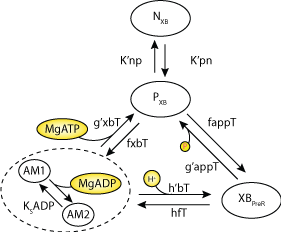Tran, Smith, Loiselle, Crampin, 2009
Model Status
This CellML model has been curated, the units are consistent and the model runs in COR and OpenCell to replicate the published results.
Model Structure
Abstract: We present a metabolically regulated model of cardiac active force generation with which we investigate the effects of ischemia on maximum force production. Our model, based on the Rice et al. (2008) model of cross-bridge kinetics, reproduces many of the observed effects of MgATP, MgADP, Pi and H+ on force development while still retaining the force/length/Ca2+ properties of the original model. We introduce three new parameters to account for the competitive binding of H+ to the Ca2+ binding site on troponin C and the binding of MgADP within the cross-bridge cycle. These parameters along with the Pi and H+ regulatory steps within the cross-bridge cycle were constrained using data from the literature and validated using a range of metabolic and sinusoidal length perturbation protocols. The placement of the MgADP binding step between two strongly-bound and force-generating states leads to the emergence of an unexpected effect on the force-MgADP curve, where the trend of the relationship (positive or negative) depends on the concentrations of the other metabolites and [H+]. The model is used to investigate the sensitivity of maximum force production to changes in metabolite concentrations during the development of ischemia.
The original paper reference is cited below:
A metabolite-sensitive, thermodynamically-constrained model of cardiac cross-bridge cycling: Implications for force development during ischemia, Kenneth Tran, Nicolas P. Smith, Denis S. Loiselle and Edmund J. Crampin, 2009, Biophysical Journal, 98, 267-276. PubMed ID: 20338848
 |
| Schematic diagram of the Tran et al. 2009 model. The original model from Rice et al. 2008 has been modified to include metabolite dependence |
